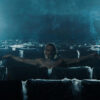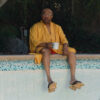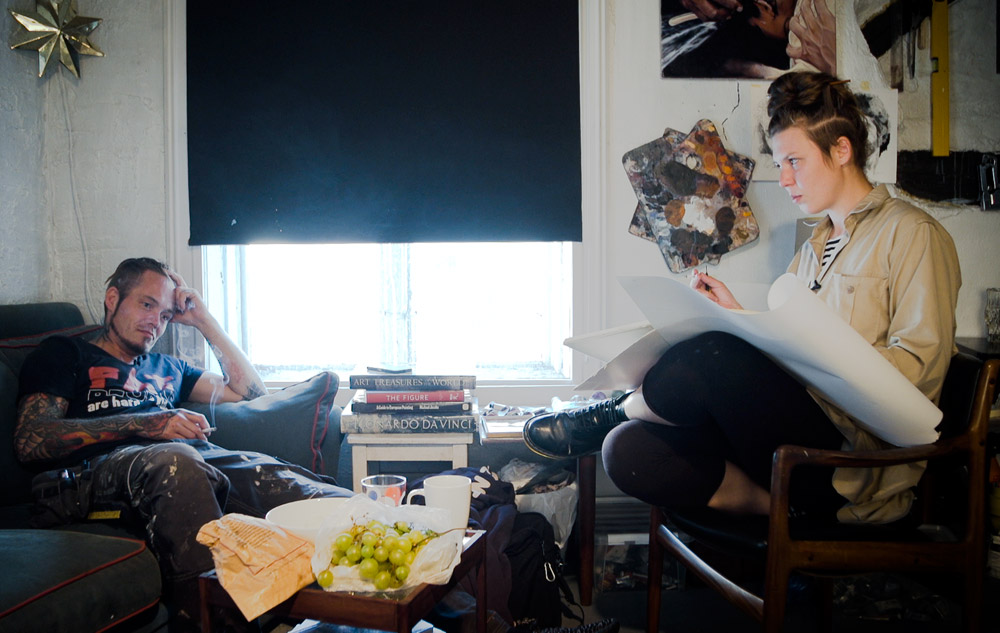Benjamin Ree had long kept an eye out to make a film about an art heist, given that his home country of Norway had a not-so-illustrious history of them with no less than Edvard Munch’s “The Scream” going missing for three months in 1994. So as he was finishing up his debut feature “Magnus” in 2015, a newspaper article about a pair of thieves that had snuck into a gallery in Oslo to steal two paintings by the artist Barbora Kysilkova had piqued his interest for a potential short. But when he contacted Kysilkova shortly after to discuss what had happened, her reaction intrigued him even more.
“I’ve tried my best to feel anger towards Bertil, but I just could not,” the artist said of Karl-Bertil Nordland, one of the two men who were arrested for stealing her work, showing curiosity about why someone would risk their livelihood to pilfer one of her paintings rather than hold them in contempt.
“Now the true crime element [of the film] only works as a framework for the story,” says Ree, who quickly shifted gears on his original plans and pursued a feature. “And the film is really about observing these two people over time and really trying to understand them.”
“The Painter and the Thief,” the end result of the four years Ree spent with Kysilkova and Nordland as they develop a most unlikely relationship, starts with an incredible premise after the former approaches the latter in court to ask why he did what he did, but it evolves into an even more remarkable rumination on how far a little empathy will go when Kysilkova begins asking questions of Nordland that no one ever has, immediately accepting him and his hazy memories of the night in question to discover who he is apart from the crime he committed. Not only does Nordland prove to be an inspiring subject to Kysilkova, who begins to paint portraits of him, but to Ree, who puts in the time to observe how he’s able to reveal things to Kysilkova about herself that she’s unconsciously suppressed or is unaware of, forming a beautiful friendship that offers support throughout trying times for them both.
At a time when we could all use someone to lean on, the film has been immediately made available to the masses after it was picked up by Neon following its premiere at Sundance, and shortly before “The Painter and the Thief” arrived in virtual cinemas and Hulu, Ree, Kysilkova and the soft-spoken Nordland recalled how the project came together and bringing this most delicate of relationships to the screen.

Barbora Kysilkova: I was more concerned for Karl-Bertil actually than for me. My life is pretty simple, so for me, it was thinking about yes or no. It was actually asking Karl Bertil whether he feels strong enough to do it.
Karl-Bertil Nordland: I felt I owed Barbora that much, so I didn’t have to think about it.
Barbora Kysilkova: There was a really nice moment with Karl-Bertil and me that was just maybe one or two years ago while the filming was still going on. We just met in my studio without cameras. We spoke about why we decided to do this film and I said to Bertil, I really wanted to show to the world what happens when you simply forgive and you let the person come to you. And I also wanted to give this insane platform for Bertil to be seen because he’s been really lacking attention for most of his life and what Bertil said was “I did it for you, I did it for your art to be seen,” and that for me was a really strong moment.
Benjamin, is it true it was about the fourth time they met that you brought in the cameras?
Benjamin Ree: They were early in their process of getting to know each other, but they got to know each other pretty fast, so in the film, you see a scene in the courtroom, and we were lucky that it was recorded. Since in the movie when they’re meeting in the movie for the first time, we’re seeing everything from Barbora’s perspective and of course, it’s Barbora who painted the courtroom drawings you see, so then it was quite easy for us because then she could just paint what she remembered and that’s how we put that together. It was crucial to have the first moment they met in the courtroom, and the next time they met, I wasn’t there with a camera, but I got access as you mentioned, so I got in very early.
Barbora Kysilkova: Of course it was nice time traveling back to this date to make these court drawings. It was quite fun and to hear the sound recording from when I first approached Bertil, it was of course a great keeping of a memory of that moment. And my dear friend in Oslo was filming me before [Benjamin]. She’s a wonderful writer and my first year in Norway, she kindly let me use her atelier for free, so I did. she was writing a big biographical book about Amalie Skram, one of the first Norwegian female authors, and she made this project into a big [investigation] into artist creativity in general, so I was quite an easy subject for her because I was constantly at the studio and she’d film my process, but of course, none of us could ever predict what it will be used for in the future.
I wondered about the first portrait Barbora painted of Bertil where he’s holding a wine glass. How did that image come to mind?
Barbora Kysilkova: Red wine is a very symbolic metaphor, and I’m not saying this from the perspective of a religious person, but it’s the blood of Jesus Christ, and as you can see in the painting, there is the gesture that one can think maybe Bertil is trying to get some dirt out of the glass or maybe a fly that just fell in, so [he’s] trying to purify the blood or to remove the dirt, and that’s how it came. And when I started to work on this composition, I actually felt this is the moment where I managed to see Bertil without his mask that he often had to put on in order to protect himself.
Benajmin Ree: After that scene with Bertil watching himself painted for the first time and his [emotional] reaction to that, I really knew that this is going to be a great story. I thought the set up of the story was amazing, but I’d go back to is that these are really great subjects that had their hearts on the outside, their emotions on the outside, so I was just very curious to see where this story might go.

Benjamin Ree: The idea for that was actually therapy. I’m very fond of how people talk when they talk in a stream of consciousness way and you often do that in psychoanalysis, so I wanted them to freely talk about each other. When we get a new friend or we get to know somebody, we talk about the trivial things, but the trivial things can say so much. And I don’t like [narration] that much in documentaries, but I like voiceovers that are a bit more stream of consciousness, like the French New Wave films, so I interviewed Barbora and Bertil in a similar setting to psychoanalysis where they get to talk freely. What they tell about each other says a lot about them as well, so you really get to better know both of them.
Barbora Kysilkova: I love that part of the movie as well, and for me, it was a really nice moment when I was speaking about Bertil. It was very nice early evening, the sun was setting and I was sitting with Benjamin in the room, just talking about Bertil and I don’t know in which situation Bertil spoke about me, but it was nice to hear his perspective on me, [because] I saw he really was paying attention to my existence in his life as well and he really was seeing quite special things in me. I’m very glad that he spoke it out loud.
Was this a challenging film to structure?
Benjamin Ree: It was very challenging to structure with multiple perspectives and also jumping back and forth in time. We didn’t choose the easy way. It took eight months in the editing room [with] myself and also three editors, and the reason why we did this was because it made it possible to explore in a much more complex way, the themes of what we humans do to be seen and appreciated and what it takes for us to see and appreciate others. I also really wanted to get across what an intelligent, charismatic guy Bertil is and the only way to do that was to see the world from his perspective.
As [Barbora] mentioned, I enjoy the sentence Bertil [says], “She sees me very well, but I can see her as well,” and that was really the whole point of the film — to see the world from both the painter and the thief’s perspectives. It’s also about how we tell stories because it’s me with a camera watching them, and they are watching each other, so there’s a meta perspective that gets in and I like the idea of people watching the film thinking about how we tell stories and how we tell each other’s stories and reflect on how we see and present each other.
Bertil, what was it like seeing your life on screen like this?
Karl-Bertil Nordland: Horrible. [all laugh] No, it was not fun. I’ve seen the film once, but I won’t see it again. [But] the film maybe helped me to own my own story a bit more and it helped me to put my past behind me, I think.
Barbora Kysilkova: Of course, it’s quite awkward to see oneself on the screen, especially if it’s a huge screen in the cinema. I was getting so much shorter with each minute of the movie when I saw it, so it took me a while to get used to it, but then I realized I can disconnect from myself while looking at the film. I can compare it a little with what I’m doing now actually. I made a painting where I really needed a woman as a model, but there is nobody around me, only me, so I had to use myself as a model for my own painting. And I actually realized it’s quite easy to disconnect from the fact that it’s yourself on the screen of the cinema or of the canvas of the painter’s atelier.
Before we all went into lockdown, what was it like to bring this out into the world?
Benjamin Ree: The film was going to be at over 30 festivals this month, so it is really sad that we couldn’t travel together with the film to different festivals because we’re still in contact all the time. I’m meeting with Bertil and Barbora every week and it would really like to travel and go out and eat dinner, so we’re really missing that, but we’re also really fortunate to have a great distributor like Neon onboard to present the film to the world and it was really great to have a premiere at Sundance. We got to have a premiere in Norway at the festival here and that was of course a really nice experience.
Barbora Kysilkova: I was very, very sad that the rule of politics and states did not allow Karl-Bertil to come to Sundance with us because that really was a huge part that was missing there. But the whole Sundance experience was totally crazy. It was my first time in the U.S. to begin with, so to meet the enormously warm and open mentality of Americans was striking. And to walk into the streets of Park City where where people recognize you and they approach you, I felt like a celebrity, though I’m just a painter that lives lockdown in the studio. Suddenly I felt so exposed, but it was marvelous because people approached me really with their own heart in their hands as they felt Bertil and I were with our hearts in our hands in front of them. Some of the people even spoke about their own private stories and that was such a great compliment to the whole work. It really made me feel like yes, we did the right thing.
“The Painter and the Thief” will be available on May 22nd on Hulu, VOD, virtual cinemas and participating Drive-Ins.




